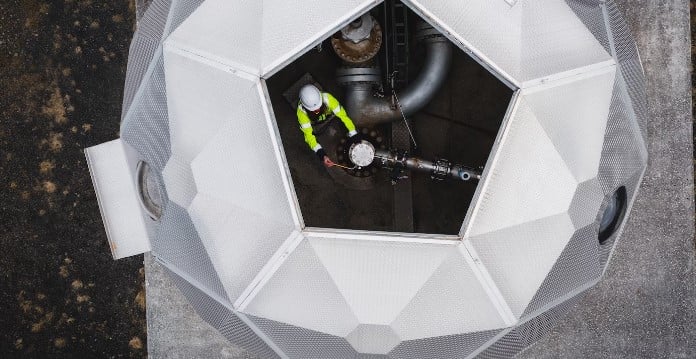
One of the more ambitious technologies of green science involves capturing CO2 emissions from the atmosphere and injecting the gas into the ground or storing it for others uses, even for something as simple as carbonizing fizzy drinks.
It sounds futuristic, but direct air capture of carbon dioxide has already been happening in Iceland for more than a decade, with much of the CO2 injected deep into the earth where it mineralizes and becomes pyrite, or fool’s gold.
Iceland’s research is now about to be exported to the US, where a 13-member consortium has been granted $3 million over two years from the US Department of Energy to study the feasibility of creating a regional hub for direct air capture and carbon mineralization in eastern Washington state, and parts of Oregon and Idaho.
It turns out the Pacific Northwest is ripe for hosting a carbon management hub because of its abundant renewable energy sources and its unique geological formations made of subterranean basaltic rock.
Iceland historically has plenty of geologic activity, including hundreds of minor earthquakes every day and occasional volcanic eruptions. A recent threat of an eruption along a fault line in the southwest part of the island has led to evacuations, as scientists offer regular updates and the public waits in suspense for what will happen next.
Iceland’s level of geologic activity is not nearly as pronounced in the Pacific Northwest, but Washington’s subterranean basaltic rock will play a key role in mineralization of CO2.
“Carbon mineralization underground does not strictly require geothermal activity,” said Angeliki Kapatza, a geothermal specialist for Reykjavik Energy, via email to Fierce Electronics. New drilling operations will be required in the region to inject the CO2, she said. “The key factors for this process include the rock’s mineral composition, its porosity, the availability of water and the presence of a CO2 capturing facility.”
Carbfix, a business unit of ON Power in Iceland, initially developed the process at its Hellisheioi geothermal power plant in southwest Iceland. The CO2 and H2S (hydrogen sulfide) emissions at the power plant are captured using a scrubbing tower, a process that, Kapatza said, “can be implemented anywhere globally, provided there is a suitable facility for CO2 capture and the rocks have the necessary mineralogy and porosity.”
In addition to the work with the consortium in the US, Carbfix is planning to expand its technology at the Coda terminal storage hub in Iceland. CO2 is captured at industrial sites in North Europe and shipped to the terminal where it is unloaded into onshore tanks for temporary storage and, later, pumped into a network of nearby injection wells. There, it is dissolved in water before being injected into fresh basaltic bedrock. It only takes two years for the CO2 trapped in carbonated fluid to convert to solid minerals.
Carbfix believes the global storage potential for CO2 mineral storage is immense. It estimates that Europe could theoretically store at least 4,000 billion tons of CO2 in rocks, while the US could store nearly double that amount. Since 2012, Carbfix has mineralized more than 90,000 tons of CO2 in Iceland with its technology. The Coda terminal received a grant from the EU Innovation Fund and is expected to mineralize 3 million tons of CO2 each year.
Multiple studies and papers about the Carbfix concept have been published since 2008 and are linked on the Carbfix site.
In addition to working with Carbfix and multiple green energy providers, the nation of Iceland is focused on exporting its sustainability concepts around the world especially for data centers. With the growth of AI, data centers and hyperscalers will be upgraded and grow in size, using more electricity and water.
RELATED: Iceland president touts nation’s role as green data center spot
RELATED: Iceland’s bid to bury CO2, amid volcanos, earthquakes
The Ankeron study, funded with $3 million by the US DOE, will be used to examine the feasibility of the Ankeron Carbon Management Hub to demonstrate extraction of legacy carbon emission from the air to be put to use or permanently stored. DOE described the hub project as a means of advancing the Justice40 initiative advanced by the Biden administration. The two-year award comes from funds in the Bipartisan Infrastructure Law approved in November 2021.
The Ankeron Hub is one of several projects picked for a first round of DOE funding that will eventually select four direct air capture hubs across the US, funded with a total of $3.5 billion from the US. Each hub must prove it can capture for the air and then store or use at least 1 million metric tons of CO2 per year, as well as create high-quality job.
The United Nations Intergovernmental Panel on Climate Change has found that carbon dioxide removal, including direct air capture will help meet the goals of the 2016 Paris Agreement. Specifically, the Ankeron Hub will attempt to demonstrate how DAC could reach the target set by DOE for a carbon negative shot target of greater than $100 per ton of durable CO2 removals by 2032.
RMI, a nonprofit, will lead the design of the hub’s governance and business model while Carbfix and Pacific Northwest National Lab will head of many of the science and technical parts of the study. Other partners include AES, a clean energy company based in the US, and Blue Planet, Heirloom, LanzaTech, Removr, Sustaera and Twelve. Washington State University will be involved in community engagement and the Washington State Department of Natural Resources will be a technical advisor while global contractor Fluor will serve as the engineering and construction provider.
RMI believes Direct Air Capture (DAC) technology is promising in removing carbon from the atmosphere at a sustainable level. “The decisions that DAC hubs make this decade on technology, energy and community benefits will have a massive impact on how DAC evolves and scales,” said Daniel Pike, principal at the Carbon Dioxide Removal Initiative at RMI. “Our consortium is determined to get it right.”
